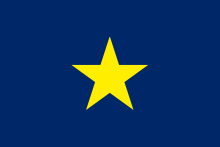
Back Republiek van Texas Afrikaans جمهورية تكساس Arabic جمهورية تكساس ARZ Texas Respublikası Azerbaijani تکزاس جومهوریتی AZB Рэспубліка Тэхас Byelorussian Република Тексас Bulgarian প্রজাতন্ত্রী টেক্সাস Bengali/Bangla República de Texas Catalan کۆماری تێکساس CKB
Republic of Texas República de Tejas (Spanish) | |||||||||||||||||||
|---|---|---|---|---|---|---|---|---|---|---|---|---|---|---|---|---|---|---|---|
| 1836–1846 | |||||||||||||||||||
| Motto: | |||||||||||||||||||
 Map of the Republic of Texas. Since the Republic was not recognized by Mexico, its entire territory was disputed. The area that was controlled by the Republic is in dark green, while the territory claimed by the Republic but not effectively controlled is in light green. | |||||||||||||||||||
| Capital |
| ||||||||||||||||||
| Official languages | English and Spanish | ||||||||||||||||||
| Other languages | German, French, Portuguese, Native languages (Caddo, Comanche) | ||||||||||||||||||
| Demonym(s) | Texian | ||||||||||||||||||
| Government | Unitary presidential constitutional republic | ||||||||||||||||||
| President1 | |||||||||||||||||||
• 1836 | David G. Burnet | ||||||||||||||||||
• 1836–38 | Sam Houston, 1st term | ||||||||||||||||||
• 1838–41 | Mirabeau B. Lamar | ||||||||||||||||||
• 1841–44 | Sam Houston, 2nd term | ||||||||||||||||||
• 1844–46 | Anson Jones | ||||||||||||||||||
| Vice President1 | |||||||||||||||||||
• 1836 | Lorenzo de Zavala | ||||||||||||||||||
• 1836–38 | Mirabeau B. Lamar | ||||||||||||||||||
• 1838–41 | David G. Burnet | ||||||||||||||||||
• 1841–44 | Edward Burleson | ||||||||||||||||||
• 1844–45 | Kenneth L. Anderson | ||||||||||||||||||
| Legislature | Congress | ||||||||||||||||||
• Upper house | Senate | ||||||||||||||||||
• Lower house | House of Representatives | ||||||||||||||||||
| Historical era | Western Expansion | ||||||||||||||||||
| March 2, 1836 | |||||||||||||||||||
| December 29, 1845 | |||||||||||||||||||
• Transfer of power | February 19, 1846 | ||||||||||||||||||
| Currency | Texas dollar | ||||||||||||||||||
| |||||||||||||||||||
| Today part of | |||||||||||||||||||
1Interim period (March 16 – October 22, 1836): President: David G. Burnet, Vice President Lorenzo de Zavala | |||||||||||||||||||



The Republic of Texas (Spanish: República de Tejas), or simply Texas, was a breakaway state in North America. It existed for 10 years, from March 2, 1836 to February 19, 1846. It shared borders with Mexico, the Republic of the Rio Grande (another Mexican breakaway republic), and the United States of America.
Much of its territory was controlled by Mexico or Comancheria; Mexico considered it a rebellious province during its entire existence. It was bordered by Mexico to the west and southwest, the Gulf of Mexico to the southeast, the two U.S. states of Louisiana and Arkansas to the east and northeast, and United States territories encompassing parts of the current U.S. states of Oklahoma, Kansas, Colorado, Wyoming, and New Mexico to the north and west. The Anglo residents of the area and of the republic were referred to as Texians.[4]
The Mexican state of Coahuila y Tejas declared its independence from Mexico during the Texas Revolution in 1835–1836, when the Centralist Republic of Mexico abolished autonomy from states of the Mexican federal republic. Major fighting ended on April 21, 1836, but the Mexican Congress refused to recognize the independence of the Republic of Texas, as the Treaties of Velasco was signed by Mexican President General Antonio López de Santa Anna under duress as prisoner of the Texians. The majority of the Mexican Congress did not approve the agreement.
Intermittent conflicts between Mexico and Texas continued into the 1840s. The United States recognized the Republic of Texas in March 1837 but declined to annex the territory at that time.[5][6]
Texas was annexed by the United States on December 29, 1845,[7] and was admitted to the Union as the 28th state on that day, with the transfer of power from the Republic to the new state of Texas formally taking place on February 19, 1846.[8] However, the United States inherited the southern and western border-disputes with Mexico, which had refused to recognize Texas's independence or to accept U.S. offers to purchase the territory. Consequently, the annexation led to the Mexican–American War (1846–1848).
- ^ "Flags and Other Symbols | TX Almanac". www.texasalmanac.com. 2023. Archived from the original on January 22, 2022. Retrieved September 26, 2023.
- ^ Greenfield, David (March 1, 2001). "Texas Tidbits". Texas Monthly. Archived from the original on October 3, 2015. Retrieved September 26, 2023.
- ^ a b c "Flags of Texas". Handbook of Texas Online. Texas State Historical Association. Retrieved June 3, 2016.
- ^ "Texian". Oxford English Dictionary (Online ed.). Oxford University Press. (Subscription or participating institution membership required.) – the term "Texian" dates from at least 1835.
- ^ Henderson (2008), p. 121.
- ^
Crapol, Edward P. (2012) [2006]. "Texas". John Tyler, the Accidental President. Legal classics library (revised ed.). University of North Carolina Press. p. 177. ISBN 978-0807872239. Retrieved May 18, 2022.
After Van Buren was safely elected, Jackson granted formal diplomatic recognition to the Lone Star Republic. A few months later, in August 1837, the Texians officially requested annexation, but Van Buren, fearing an anti-slavery backlash and domestic turmoil, rebuffed them.
- ^ O'Neill, R. (2011). Texas War of Independence. Rosen Publishing Group. p. 85. ISBN 978-1448813322.
- ^ Kelly F. Himmel (1999). The Conquest of the Karankawas and the Tonkawas: 1821–1859. Texas A&M University Press. p. 93. ISBN 978-0-89096-867-3.

